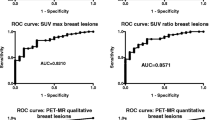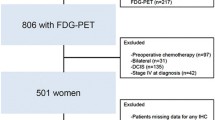Abstract
Fluorodeoxyglucose-positron emission tomography (FDG-PET) is a noninvasive imaging technique capable of identifying primary tumors and metastases with high sensitivity and accuracy. The aim of this study was to evaluate the diagnostic accuracy of whole-body FDG-PET imaging for the detection of recurrent or metastatic breast cancer after surgery. Whole-body FDG-PET imaging was performed on 27 patients with suspected recurrent breast carcinoma. PET images were evaluated qualitatively for each patient and lesion. FDG-PET scans showed that there were 61 reference sites of malignant or benign lesions in 27 patients. In a patient-based analysis, FDG-PET scans correctly identified 16 of 17 patients with recurrent or metastatic disease and 8 of 10 without recurrence, resulting in a sensitivity, specificity, and accuracy of 94%, 80%, and 89%, respectively. In a lesion-based analysis, FDG-PET scans correctly identified 46 of 48 lesion sites with recurrent or metastatic disease and 11 of 13 without recurrence. The overall sensitivity, specificity, and accuracy for all lesion sites were 96%, 85%, and 93%, respectively. FDG-PET scans revealed unsuspected recurrent or metastatic diseases in 8 of 27 (30%) of patients and 11 of 20 (55%) distant metastatic lesions. In 13 patients treatment was altered by the outcome of the PET scan. We concluded that whole-body FDG-PET scan is a useful diagnostic imaging modality for detecting recurrent or metastatic breast carcinoma in patients suspected of having recurrent disease after primary surgery.
Résumé
On sait que le PET scan au FDG est une technique d’imagerie non-invasive capable d’identifier les tumeurs primitives et métastatiques avec une sensibilité et une précision élevées. Le but de cette étude a été d’évaluer la précision diagnostique du PET-FDG scan corps entier pour détecter une récidive ou des métastases du cancer du sein après intervention chirurgicale. Un PET-FDG scan corps entier a été réalisé chez 27 patientes suspectées d’avoir une récidive de cancer du sein. Les images ont été évaluées qualitativement pour chaque patiente et chaque lésion. L’analyse des images a montré 61 sites de lésions malignes ou bénignes chez ces 27 patientes. En ce qui concerne l’analyse individualisée par patiente, le PET-scan a correctement identifié 16 des 17 patientes ayant une récidive ou des métastases et 8 des 10 patientes sans récidives, pour une sensibilité, une spécificité et une précision respectivement de 94%, 80% et de 89%. En ce qui concerne l’analyse individualisée par lésions, le PET-FDG scan a correctement identifié 46 des 48 sites de récidives ou de métastases et 11 des 13 lésions sans métastases pour une sensibilité, une spécificité et une précision globales respectivement de 96%, 85% et de 93%. Le PET-FDG scan a révélé une récidive ou des métastases non suspectées chez 8 des 27 (30%) patientes et chez 11 des 20 (55%) patientes ayant déjà une métastase à distance. Le plan thérapeutique a été modifié par les résultats du PET scan chez 134 patientes. Nous concluons que le PET-FDG scan corps entier est utile pour la détection de récidives ou de métastases chez la patiente soupçonnée de récidive après chirurgie primitive pour cancer du sein.
Resumen
La FDG-PET es una técnica no invasora de imágenes diagnósticas, capaz de identificar con alta sensibilidad y certeza tumores primarios y metástasis. El propósito del presente estudio fue evaluar la certeza diagnóstica de la imagenología de cuerpo entero por FDG-PET en la detección de carcinoma de seno recurrente o metastásico luego de tratamiento quirúrgico. La imagenología de cuerpo entero con FDG-PET se practicó en 27 pacientes con sospecha de carcinoma mamario recurrente. Las imágenes fueron evaluadas cualitativamente para cada paciente y cada lesión. Los estudios demonstraron 61 ubicaciones de lesiones malignas o benignas en 27 pacientes. En el análisis basado en el paciente, los estudios con FDG-PET identificaron correctamente 16 de 17 pacientes con enfermedad recurrente o metastásica y 8 de 10 libres de recurrencia. lo cual significó sensibilidad, especificidad y certeza de 94%, 80% y 89%, respectivamente. En el análisis basado en la lesión, las imágenes identificaron correctamente 46 de 48 ubicaciones de lesiones, con enfermedad recurrente o metastásica de 11 y 13 libres de recurrencia. Las tasas globales de sensibilidad, la especificidad y la certeza para todas las ubicaciones fueron 96%, 85% y 93%, respectivamente. Los estudios con FDG-PET revelaron enfermedad recurrente o metastásica no sospechada en 8 de 27 (30%) pacientes y lesiones metastásicas distantes en 11 de 20 (55%). En 13 pacientes se modificó el tratamiento como resultado del estudio por PET. Nuestra conclusión es que la escanografía de cuerpo entero por FDG-PET es una modalidad de imagenología diagnóstica útil en la detección de carcinoma recurrente o metastásico en pacientes con sospecha de enfermedad recurrente luego de tratamiento quirúrgico primario.
Similar content being viewed by others
References
Moon, D.H., Maddahi, J., Silverman, D.H.S., Glaspy, J.A., Phelps, M.E., Höh, C.K.: Accuracy of whole-body fluorine-18-FDG PET for the detection of recurrent or metastatic breast carcinoma. J. Nucl. Med. 39:431, 1998
Bender, H., Kirst, J., Palmedo, H., Schomburg, A., Wagner, U., Ruhlmann, J., Biersack, HJ.: Value of 18fluoro-deoxyglucose positron emission tomography in the staging of recurrent breast carcinoma. Anticancer Res. 77:1687, 1997
Cook, G.J., Houston, S., Rubens, R., Maisey, M.N., Fogelman, L: Detection of bone métastases in breast cancer by 18FDG PET: differing metabolic activity in osteoblastic and osteolytic lesions. J. Clin. Oncol. 16:3375, 1998
Noh, D.Y., Yun, I.J., Kim, J.S., Kang, H.S., Lee, D.S., Chung, J.K., Lee, M.C., Youn, Y.K., Oh, S.K., Choe, K.J.: Diagnostic value of positron emission tomography for detecting breast cancer. World J. Surg. 22:223, 1998
Flanagan, F.L., Dehdashti, F., Siegel, B.A.: PET in breast cancer. Semin. Nucl. Med. 25:290, 1998
Wahl, R.L., Cody, R., Hutchins, G., Mudgett, E.: Primary and meta-static breast carcinoma: initial clinical evaluation with PET with radiolabeled glucose analogue 2-[F-18]-fluoro-2-deoxy-D-glucose. Radiology 779:765, 1991
Hoh, C.K., Hawkins, R.A., Glaspy, J.A., Dahlbom, M., Tse, N.Y., Hoffman, E.J., Schiepers, C., Choi, Y., Rege, S., Nitzsche, E., Maddahi, J., Phelps, M.E.: Cancer detection with whole-body PET using 2-[18F]fluoro-2-deoxy-D-glucose. J. Comput. Assist. Tomogr. 77:582, 1993
Nieweg, O.E., Kim, E.E., Wong, W.H., Broussard, W.E., Singletary, S.E., Hortobagyi, G.N., Tilbury, R.S.: Positron emission tomography with fluorine-18-deoxyglucose in the detection and staging of breast cancer. Cancer 77:3920, 1993
Wahl, R.L., Zasadny, K., Helvie, M., Hutchins, G.D., Weber, B., Cody, R.: Metabolic monitoring of breast cancer chemohormonotherapy using positron emission tomography: initial evaluation. J. Clin. Oncol. 77:2101, 1993
Jansson, T., Westlin, J.E., Ahlström, H., Lilia, A., Langström, B., Bergh, J.: Positron emission tomography studies in patients with locally advanced and/or metastatic breast cancer: a method for early therapy evaluation? J. Clin. Oncol. 75:1470, 1995
Bruce, D.M., Evans, N.T.S., Heys, S.D., Needham, G., BenYounes, H., Mikecz, P., Smith, F.W., Sharp, F., Eremin, O.: Positron emission tomography: 2-deoxy-2-[18F]-fluoro-D-glucose up-take in locally advanced breast cancers. Eur. J. Surg. Oncol. 27:280, 1995
Vahdat, L., Animan, K.: High dose therapy for breast cancer. Blood Rev. 9:191, 1995
Antman, K., Ayash, L., Elias, A., Wheeler, C., Hunt, M., Eder, J.P., Teicher, B.A., Critchlow, J., Bibbo, J., Schnipper, L.E.: A phase II study of high-dose cyclophosphamide, thiotepa, and carboplatin with autologous marrow support in women with measurable advanced breast cancer responding to standard-dose therapy. J. Clin. Oncol. 70:102, 1992
Vaughan, W.P.: Autologous bone marrow transplantation in the treatment of breast cancer: clinical and technologic strategies. Semin. Oncol. 20:55, 1993
Wahl, R.L., Cody, R., Hutchins, G., Mudgett, E.: Positron emission tomographic scanning of primary and metastatic breast carcinoma with the radiolabeled glucose analogue 2-deoxy-2-[18F]fluoro-D-glucose. N. Engl. J. Med. 324:200, 1991
Adler, L.P., Faulhaber, P.F., Schnur, K.C., Al-Kasi, N.L., Shenk, R.R.: Axillary lymph node métastases: screening with [F-18]2-deoxy-2-fluoro-D-glucose(FDG) PET. Radiology 203:323, 1997
Avril, N., Dose, J., Jänicke, F., Ziegler, S., Römer, W., Weber, W., Herz, M., Nathrath, W., Graeff, H., Schwaiger, M.: Assessment of axillary lymph node involvement in breast cancer patients with positron emission tomography using radiolabeled 2-(fluorine-18)-fluoro-2-deoxy-D-glucose. J. Nati. Cancer Inst. 55:1204, 1996
Scheidhauer, K., Scharl, A., Pietrzyk, U., Wagner, R., Göhring, U., Schämacker, K., Schicha, H.: Qualitative [18F]FDG positron emission tomography in primary breast cancer: clinical relevance and practica-bility. Eur. J. Nucl. Med. 25:618, 1996
Tse, N.Y., Höh, C.K., Hawkins, R.A., Zinner, M.J., Dahlborn, M., Choi, Y., Maddahi, J., Brunicardi, F.C., Phelps, M.E., Glaspy, J.A.: The application of positron emission tomography with fluorodeoxy-glucose to the evaluation of breast disease. Ann. Surg. 216:27, 1992
Smith, I.C., Ogston, K.N., Whitford, P., Smith, F.W., Sharp, P., Norton, M., Miller, I.D., Ah-See, A.K., Heys, S.D., Jibril, J.A., Eremin, O.: Staging of the axilla in breast cancer: accurate in vivo assessment using positron emission tomography with 2-(fluorine-18)-fluoro-2-deoxy-D-glucose. Ann. Surg. 225:220, 1998
Crippa, F., Agresti, R., Seregni, E., Greco, M., Pascali, C., Bogni, A., Chiesa, C., Sanctis, V., Delledonne, V., Salvadori, B., Leutner, M., Bombardieri, E.: Prospective evaluation of fluorine-18-FDG PET in presurgical staging of the axilla in breast cancer. J. Nucl. Med. 59:4, 1998
Avril, N., Bense, S., Ziegler, S.I., Dose, J., Weber, W., Laubenbacher, C., Römer, W., Jänicke, F., Schwaiger, M.: Breast imaging with fluorine-18-FDG PET: quantitative image analysis. J. Nucl. Med. 55:1186, 1997
Avril, N., Dose, J., Jänicke, F., Bense, S., Ziegler, S.I., Laubenbacher, C., Römer, W., Pache, H., Herz, M., Allgayer, B., Nathrath, W., Graeff, H., Schwaiger, M.: Metabolie characterization of breast tumors with positron emission tomography using F-18 fluorodeoxyglucose. J. Clin. Oncol. 77:1848, 1996
Author information
Authors and Affiliations
Corresponding author
Additional information
Published Online: June 12, 2001
Rights and permissions
About this article
Cite this article
Kim, TS., Moon, W.K., Lee, DS. et al. Fluorodeoxyglucose positron emission tomography for detection of recurrent or metastatic breast cancer. World J. Surg. 25, 829–834 (2001). https://doi.org/10.1007/s002680020095
Issue Date:
DOI: https://doi.org/10.1007/s002680020095




